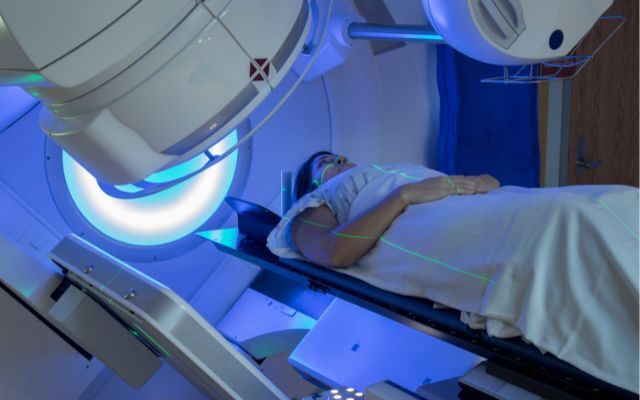Attention GCI Patients — Effective October 6, 2025, the GCI Oak Lawn location will be closed. All patients of GCI Oak Lawn will be seen at our Chicago Ridge location at 10604 Southwest Highway, Suite 109, Chicago Ridge, IL 60415.
January 3, 2025
What is Stage 0 Breast Cancer and How Is It Treated?

Stage 0 breast cancer, also called ductal carcinoma in situ, is a non-invasive type of breast cancer at its very earliest stage. It’s usually only found through a screening mammogram because there are no symptoms, and the lump is too small to be felt. Without treatment, however, it will grow into a later stage when more therapies are required to treat it successfully.
How do oncologists treat Stage 0 breast cancer, and what type of outcome should you expect?
Understanding Stage 0 Breast Cancer
When a lump in the breast is diagnosed as breast cancer, one of the first things your oncologist will do is determine its stage. This helps provide a clearer understanding of how advanced the cancer is and whether it has spread beyond the breast. The breast cancer stages range from Stage 0, the earliest and least advanced, to Stage IV, the most advanced.
In addition to the stage, several other characteristics of breast cancer will be determined, mainly from the biopsy results and possibly some additional tests.
Ductal carcinoma in situ is one of several types of breast cancer. "In situ" means the cancer cells are confined to the milk duct lining and have not grown further in the breast or affected the lymph nodes. Once the cancer has grown further, it will be considered invasive ducal carcinoma or invasive lobular carcinoma, depending on where the cancer started.
There is also a determination of whether your breast cancer is hormone-positive, meaning that estrogen, progesterone, or both are fueling the cancer’s growth. There is also a determination of whether an overgrowth of the HER2 protein is helping the cancer grow. This is referred to as HER2-positive breast cancer.
This information is put together to create a treatment plan that is most likely to work best.
Diagnosing Stage 0 Breast Cancer
If you received a Stage 0 breast cancer diagnosis, more than likely, it appeared as an abnormal area on a mammogram. Your doctor will order additional imaging tests, such as a diagnostic mammogram, a breast ultrasound, or a breast MRI. If these images show the same area of concern, a biopsy is next. During a biopsy, some breast tissue is removed so it can be checked for cancer. A biopsy is the only guaranteed way to confirm a breast cancer diagnosis.
If your biopsy results confirm that cancer is present, even if it’s very early, you will need to meet with a breast cancer oncologist. During your first visit with the cancer doctor, you will discuss the biopsy findings, called a pathology report, and additional tests may be needed before deciding the best path for treatment.
Because this type of breast cancer is very small and confined to one area, your lymph nodes are most likely unaffected. However, to be sure, your breast cancer specialist and surgeon are likely to remove and test, at least, the lymph node closest to the tumor to see if the cancer has grown into the lymph system. If it has, you will be restaged, and additional treatments will most likely be needed.
Find out how to plan for your first visit with a breast cancer specialist.
Treatment Options for Stage 0 Breast Cancer
Treatment for Stage 0 breast cancer can be approached in several ways. Your medical oncologist will typically lead the care team, collaborating with a breast cancer surgeon, radiation oncologist, and other healthcare professionals involved in your treatment plan.
Active Surveillance
Because Stage 0 breast cancer is so small and because there is some risk involved with treatment, your oncologist may suggest that you wait before removing the tumor. This is called active surveillance.
You will regularly visit your breast cancer oncologist to monitor the condition and run more tests to see if it’s growing. A breast MRI is usually performed every three to six months. If there are signs of progression, you can begin treatment, most likely starting with surgery. For some patients, active surveillance for DCIS can last for several years as long as their cancer doesn’t further advance.
Breast Cancer Surgery
Surgery is the most common treatment recommendation for ductal carcinoma in situ or Stage 0 breast cancer. Many women with DCIS can undergo breast-conserving surgery, also called a lumpectomy. This procedure involves removing the cancer cells while preserving healthy breast tissue. The surgeon also excises a margin of tissue around the cancer to ensure that any potentially affected cells are removed.
If multiple areas of DCIS are discovered throughout the breast, a mastectomy, which removes the entire breast, may be suggested instead. If you’re undergoing a mastectomy and considering breast reconstruction, you may want to talk with a plastic surgeon before having cancer surgery.
It’s during this surgery that your closest lymph node to the tumor, called the sentinel lymph node, may be removed for testing.
Your breast cancer surgeon will help you determine the type of surgery that will be most effective for you.
Breast Cancer Radiation
After a lumpectomy for Stage 0 breast cancer, radiation therapy is typically recommended to reduce the risk of the cancer returning. This can be internal or external beam radiation therapy.
Internal radiation therapy for breast cancer, called high-dose-rate brachytherapy, takes only a few days to complete and is best for those who had early-stage cancer removed. Several tubes are inserted into the breast in the area where the cancer was removed. These tubes are left in place for a few days, usually three to five days. Each day, small pellets of radioactive material are inserted into the tubes and left in place to treat the area around the surgical site. This is repeated over several days, and then the tubes are removed.
External radiation therapy uses high-energy beams to destroy cancer cells. The area where the cancer was located is targeted carefully using beams that are customized to the size and shape of the surgical site. This requires multiple treatments each week. Although each session is relatively short, external beam radiation treatments will continue five days a week for at least a few weeks.

Is Stage 0 Breast Cancer Treated with Hormone Therapy or Targeted Therapy?
Other breast cancer treatments, such as hormone therapy and targeted therapy, can be used for Stage 0 breast cancer. The use of these therapies typically depends on the presence of hormone receptors that can promote cancer growth and if the cancer is HER2-positive.
If Stage 0 breast cancer is determined to be hormone receptor-positive, hormone therapy is likely to be included in the treatment plan. This therapy blocks estrogen and/or progesterone receptors, slowing tumor growth and reducing the likelihood of cancer recurrence.
Targeted therapy is another potential treatment for Stage 0 breast cancer if the cells test positive for HER2 protein receptors. This approach uses medications that can identify specific cell characteristics, allowing them to bind and block these receptors, which inhibits cancer growth. In this case, the targeted therapy would block the excess HER2 receptors on the cancer cells to prevent further growth.
Determining the Best Treatment Approach for Stage 0 Cancer
For patients with Stage 0 breast cancer, there is a commonly recommended treatment plan. However, your individual plan might vary based on the characteristics of the cancer and your personal preferences.
To determine the best treatment approach, your breast cancer specialist will consider several factors, including:
Potential overtreatment: Overtreating Stage 0 breast cancer can lead to unnecessary side effects, which could be avoided if active surveillance is sufficient.
Personal preference: If your oncologist recommends active surveillance, you may experience anxiety about whether the cancer is growing. If you aren’t comfortable with this approach, talk to your oncologist about starting a treatment plan sooner.
Your overall health. Factors such as your age and existing health conditions can influence the intensity and timing of your treatment.
Feel free to discuss your preferences with the oncologist, even if you think about it and change your mind. It’s OK. Just be sure to communicate your preferences.
Personalized Early-Stage Breast Cancer Care in South Chicago
If a breast biopsy shows that a small area of cancer is present, it’s best to schedule an appointment with an oncologist who specializes in breast cancer. The breast cancer doctors at Affiliated Oncologists are available for a consultation. They will recommend a treatment plan using the most recent and advanced treatment options. We are also available to give you second opinions before you start treatment.
Our offices are located throughout the South Chicago suburbs in Chicago Ridge, Mokena, Hazel Crest, Oak Lawn, Orland Park, and Palos Heights, IL. Request an appointment at the location most convenient for you.
Categories: Breast Cancer